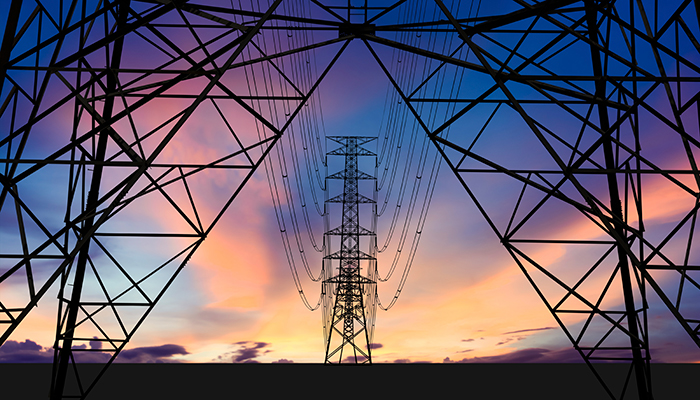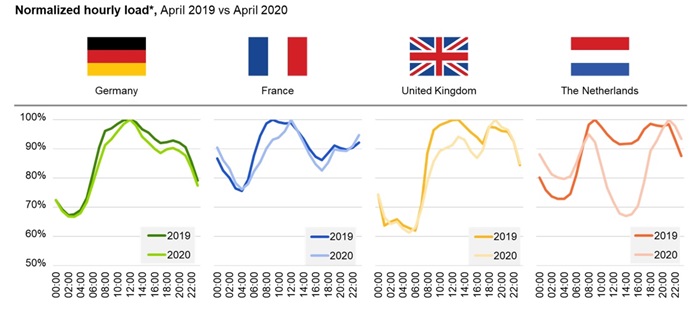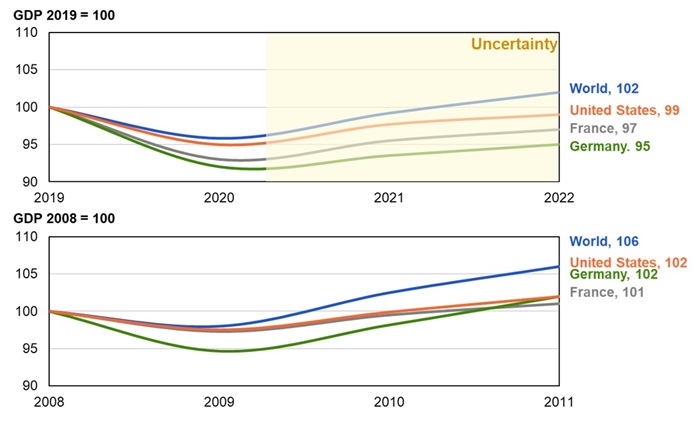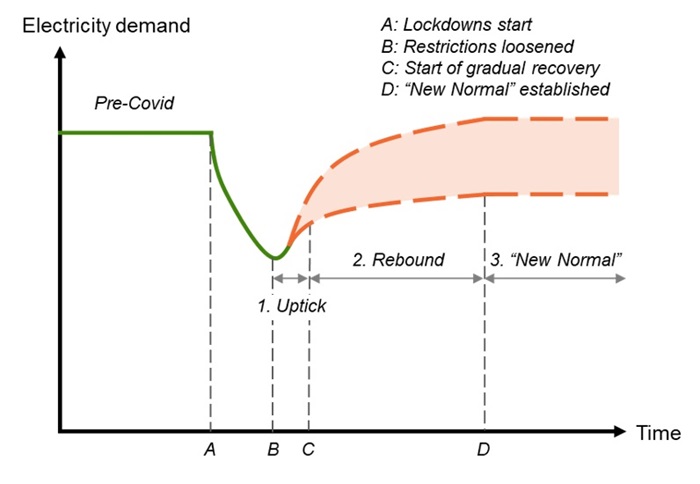- Electricity Sales
- Electricity Generation
- Europe
- Utilities
- Electric Utilities
Uncertainty of European Electricity Demand through COVID-19 Recovery

This blog was coauthored by Oliver McShane, Artur Lenkowski, and Anthony Wang
Physical distancing restrictions and the associated drop in economic activity have caused electricity demand to fall by 10%-20% across Europe and patterns of electricity consumption are expected to change dramatically
The magnitude and speed of collapse in economic activity that followed the coronavirus outbreak is unlike anything experienced in recent decades. While European countries simultaneously battle health and financial crises, utilities face threats on multiple fronts. Collapsing commodity prices, electricity demand reductions of 10%-20%, and the possibility of write-offs are affecting business performance. The future is uncertain. The International Monetary Fund’s April 2020 World Economic Outlook projects global growth in 2020 to fall to -3%. This makes the “Great Lockdown the worst recession since the Great Depression, and far worse than the Global Financial Crisis.”
Beyond reductions in absolute demand volumes, recent data suggests that patterns of electricity consumption are shifting due to falling commercial and industrial demand (business-to-business) and rising residential demand (business-to-consumer). For retailers and generators, the every-day-is-a-weekday phenomenon is causing increased short-term forecasting errors and consequently higher imbalance costs. The following figure shows how morning and afternoon periods are most impacted as people no longer follow strict routines and workplaces are empty. Changes also vary depending on the levels of distributed generation. The lunchtime dip in the Netherlands is due to growth in distributed solar PV capacity combined with sunny weather.
Comparison of Normalized Hourly Load: April 2019 and April 2020

Note: Loads are weather unadjusted and cover weekdays only.
(Source: ENTSO-E)
The Nature of Electricity Demand Recovery Is Uncertain
While this 10%-20% electricity demand drop is not expected to be permanent, when and how it bounces back is uncertain. Despite the long-term decoupling of GDP and energy growth, the Global Financial Crisis showed that during downturns electricity demand picks up in line with GDP. The question is how demand will recover this time around considering that the immediate drop is more pronounced and that this recession is forecast to be more severe than the previous one both in terms of GDP impact and recovery time, as shown in the figure below. The jury is out on whether the behavioral shifts that caused changes in consumption patterns persist post-pandemic.
Forecast GDP Due to Impact from COVID-19 and Economic Development During the 2008 - 2009 Recession

(Source: CEBR, Statista, World Bank)
Guidehouse sees electricity demand recovering in three phases. Each phase has multiple scenarios, as follows:
- Phase 1: Near-term uptick. In the near-term, a loosening of physical distancing restrictions will cause an uplift as a portion of commercial and industrial activity resumes.
- Phase 2: Economy-linked rebound. As society adapts to safe working, electricity demand will rebound. We expect the duration of this phase to follow that of the economic recovery. While the latter remains a topic of uncertainty, the Centre for Economics and Business Research suggests that European GDP could return to 2019 levels in 2022 or later. Additionally, responsiveness to potential second waves of infections will be essential during this phase.
- Phase 3: The new normal. In the final phase, the eventual discovery of a vaccine or herd immunity will cause demand to converge to a new normal. Society either returns to pre-pandemic consumption patterns or adopts permanent behavioral shifts that fundamentally alter the way electricity is consumed.
Simplified Timeline of the Three Phases of Electricity Demand Recovery

(Source: Guidehouse)
To navigate recovery, utilities and energy companies need to adapt their planning and business processes to account for greater uncertainty in both the short- and long-term
The shape and pace of demand recovery is a critical factor in utilities’ business planning. As utilities move beyond immediate crisis response mode and look to the future, executives must be prepared to navigate their organizations through a turbulent economic recession unlike any other, into a future that will look different from the recent past.
Players across the value chain need to assess the levels of uncertainty they face, incorporate scenario planning into business operations, build inherent flexibility and resiliency into their systems and processes, and accelerate digitization efforts in preparation for the new normal. More specifically:
- Generators must monitor impacts on the generation mix, portfolio profitability (capacity factors, capture prices), and implications for investments and financing of new projects.
- Distribution companies and system operators must examine the impact on regulated revenues, system inertia issues, and revise their flexibility procurement strategies to manage the changes in grid stability and renewable curtailment.
- Retailers should consider the impact on electricity sales, the extent of their merchant and credit risk exposure, and revise hedging strategies, digital sales channels, and AI-based customer engagement processes to address shifting consumption behavior.
We invite you to contact us to set up a time to discuss this blog or other topics:
- Ben Grunfeld, Partner, Energy Providers, Europe
- Shannon Graham, Director, Solutions, Europe